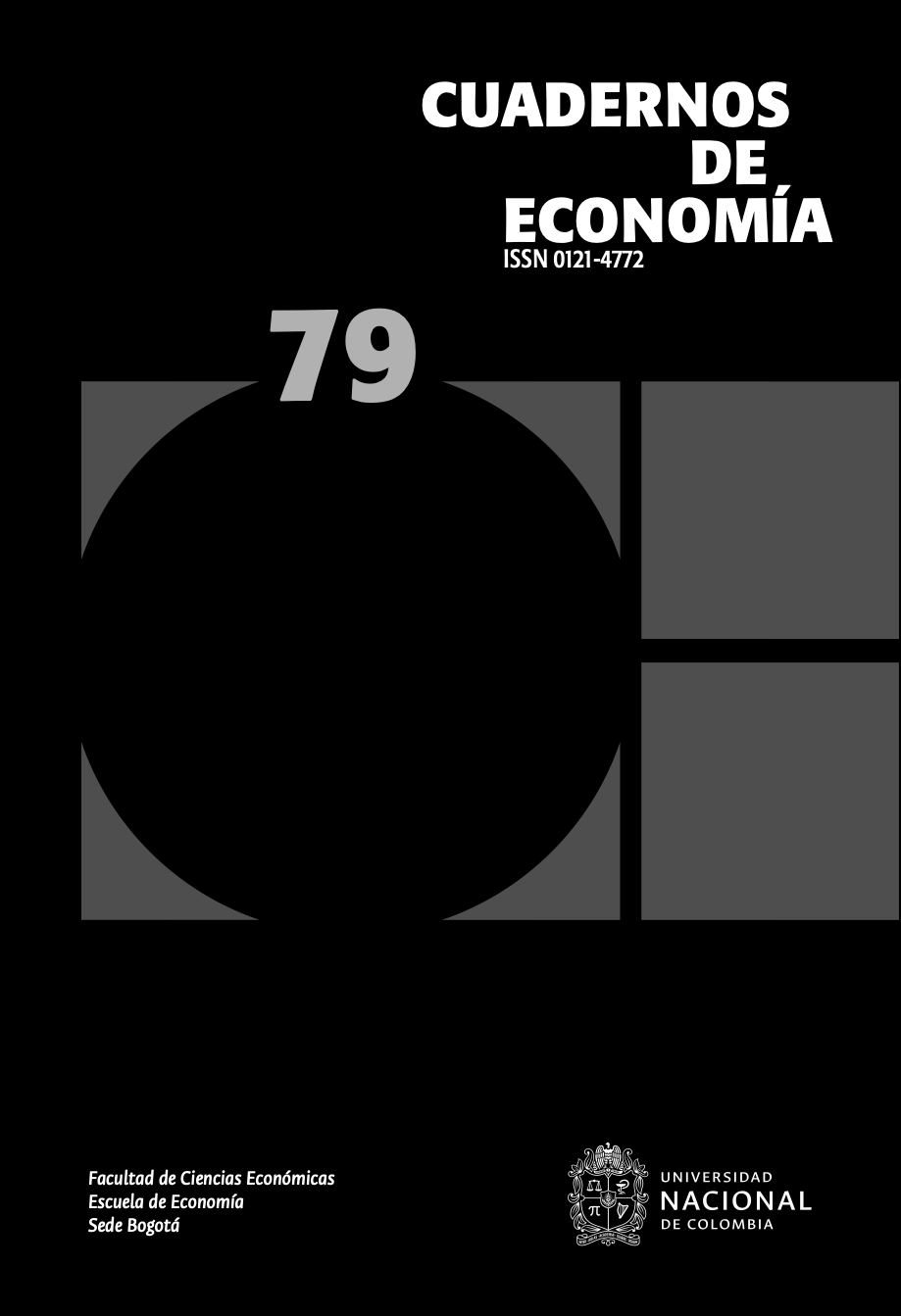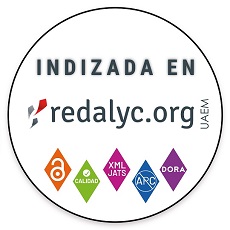Pobreza, género y diferencias en la participación y ocupación en el sector informal en México
Poverty, gender and differences in participation and occupation in the informal sector in Mexico
Pobreza, gênero e diferenças na participação e ocupação no setor informal no México
DOI:
https://doi.org/10.15446/cuad.econ.v39n79.63246Palabras clave:
Sector informal, Género, Pobreza, Ocupación, México (es)Informal sector, gender, poverty, employment, Mexico (en)
setor informal, gênero, pobreza, ocupação, México (pt)
Descargas
Recent literature on the informal sector incorporates the notion of heterogeneity and argues that the peculiarities of its subdivisions should not be ignored. Analyzing the interactive effects of gender, poverty level, and occupation, the empirical evidence presented in this paper confirms the importance of incorporating this notion in empirical studies focused on Mexico. The results show a positive and significant relationship between the level of poverty and the difference in the probability of women and men to participate in the informal sector as self-employed and subordinate workers.
A literatura recente sobre o setor informal incorpora a noção de heterogeneidade e sustenta que não devem ser ignoradas as peculiaridades de suas subdivisões. Ao analisar a relação interativa entre gênero, nível de pobreza e posição na ocupação, a evidência empírica apresentada neste trabalho confirma a importância de incorporar esta noção nestes estudos empíricos concentrados no México. Os resultados mostram uma relação positiva e significativa entre o nível de pobreza e a diferença na probabilidade de que as mulheres e os homens participem no setor informal como trabalhadores por conta própria e subordinados.
Referencias
Aguilar Barceló, J.G., Hernández Campos, C.M., & Ramírez Uriquidi, M.A. (2010). Efecto del ciclo económico en la incidencia de la informalidad: evidencia para México, 1987-1999. Economía y Sociedad, 14(25), 91-109.
Biles, J.J. (2008). Informal work and livelihoods in Mexico: Getting by or getting ahead? The Professional Geographer, 60(4), 541-555. doi: 10.1080/00330120802288743
Bosch, M., & Maloney, W.F. (2010). Comparative analysis of labor market dynamics using Markov processes: An application to informality. Labour Economics, 17(4), 621-631. doi: 10.1016/j.labeco.2010.01.005
Chaudhuri, S., & Mukhopadhyay, U. (2009). Revisiting the Informal Sector: A General Equilibrium Approach. New York: Springer
Chen, M.A. (2001). Women and informality: A global picture, the global movement. The SAIS Review, 21(1), 71-82. doi:10.1353/sais.2001.0007
Cicowiez, M., Gasparini, L., Gutiérrez, F., & Tornarolli, L. (2006). Áreas rurales y objetivos de desarrollo del milenio en América Latina y el Caribe (CEDLAS Documento de Trabajo No. 43). Buenos Aires: Universidad Nacional de la Plata. Recuperado de http://www.cedlas.econo.unlp.edu.ar/wp/wp-content/uploads/doc_cedlas43.pdf
CONEVAL (2015). Resultados de pobreza en México 2014 a nivel nacional y por entidades federativas. Recuperado de https://www.coneval.org.mx/Medicion/MP/Paginas/Pobreza_2014.aspx
Cunningham, W. (2001). Sectoral allocation by gender of Latin American workers over the liberalization period of the 1990s (Policy Research Working Paper No. 2742). Washington, DC: World Bank.
Deere, C., Alvarado, G., & Twyman, J. (2012) Gender Inequality in Asset Ownership in Latin America: Female Owners vs Household Heads. Development and Change, 43(2), 505-530. doi:10.1111/j.1467-7660.2012.01764.x
Fields, G.S. (1990). Labour market modelling and the urban informal sector: Theory and evidence. En D. Turnham, B. Salomé & A. Schwarz (Eds.), The informal sector revisited (pp. 49-69). Paris: Organisation for Economic Co-operation and Development.
Fields, G.S. (2004). A guide to multisector labor market models. (Working paper 11-2004) Cornell University, School of Industrial and Labor Relations. Recuperado de https://digitalcommons.ilr.cornell.edu/workingpapers/86/
Franzese, R. J., & Kam, C. (2007). Modeling and interpreting interactive hypotheses in regression analysis. University of Michigan Press. doi:10.3998/mpub.206871
Freije, S. (2001). El empleo informal en America Latina y el Caribe: Causas, consecuencias y recomendaciones de política (Serie Documentos de Trabajo Mercado Laboral). Washington, DC: Banco Interamericano de Desarrollo
Funkhouser, E. (1996). The urban informal sector in Central America: Household survey evidence. World Development, 24(11), 1737-1751.
Gasparini, L., & Tornarolli, L. (2009). Informalidad laboral en América Latina y el Caribe: Patrones y tendencias a partir de microdatos de encuestas de hogares. Desarrollo y Sociedad, (63), 13-80.
González de la Rocha, M., & Escobar Latapí, A. (2008). Choices or constraints? Informality, labour market and poverty in Mexico. Institute of Development Studies Bulletin, 39(2), 37-47. doi:10.1111/j.1759-5436.2008.tb00443.x
Günther, I., & Launov, A. (2012). Informal employment in developing countries: Opportunity or last resort? Journal of Development Economics, 97(1), 88-98. doi:10.1016/j.jdeveco.2011.01.001
Harris, J.R., & Todaro, M.P. (1970). Migration, unemployment and development: A two-sector analysis. The American Economic Review, 60(1), 126-142
Heckman, J.J., Urzua, S., & Vytlacil, E. (2006). Understanding instrumental variables in models with essential heterogeneity. The Review of Economics and Statistics, 88(3), 389-432. doi:10.3386/w12574
Hussmanns, R. (2004). Measuring the informal economy: From employment in the informal sector to informal employment (Policy Integration Department Working Paper No. 53). Geneva: International Labour Organization. Recuperado de https://www.ilo.org/wcmsp5/groups/public/---dgreports/---integration/documents/publication/wcms_079142.pdf
NEGI (2015). Encuesta Nacional de Empleo y Ocupación. Resultados para el primer trimestre del 2014. Boletín de prensa núm. 208/14. Recuperado de http://www.ilo.org/surveydata/index.php/catalog/1939/download/15332
La Porta, R., & Shleifer, A. (2014). Informality and development. The Journal of Economic Perspectives, 28(3): 109-126. doi:10.3386/w20205
Levy, S. (2008). Good intentions, bad outcomes: Social policy, informality and economic growth in Mexico. Washington, DC: Brookings Institution Press
Lewis, W.A. (1954). Economic development with unlimited supplies of labor. The Manchester School, 22(2), 139-191. doi:10.1111/j.1467-9957.1954.tb00021.x
Lewis, W.A. (1979). The dual economy revisited. The Manchester School, 47(3), 211-229. doi:10.1111/j.1467-9957.1979.tb00625.x
Loayza, N.V., Servén, L., & Sugawara, N. (2009). Informality in Latin America and the Caribbean (Policy Research Working Paper Series 4888). Washington, DC: World Bank. Recuperado de http://documents.worldbank.org/curated/en/532851468047799334/Informality-in-LatinAmericaand-the-Caribbean
Loayza, N.V., & Sugawara, N. (2009). El sector informal en México: Hechos y explicaciones fundamentales. El Trimestre Económico, 76(304), 887-920.
Maloney, W.F. (1999). Does informality imply segmentation in urban labor markets? Evidence from sectoral transitions in Mexico. The World Bank Economic Review, 13(2), 275-302.
Maloney, W.F. (2004). Informality revisited. World Development, 32(7), 1159-1178. doi:10.1016/j.worlddev.2004.01.008
Marcouiller, D., Ruiz de Castilla, V., & Woodruff, C. (1997). Formal measures of the informal wage gap in Mexico, El Salvador, and Peru. Economic Development and Cultural Change, 45(2), 367-392.
Mitchell, M. N. (2012). Interpreting and visualizing regression models using Stata. College Station, TX: Stata Press.
Nguimkeu, P. (2014). A structural econometric analysis of the informal sector heterogeneity. Journal of Development Economics, 107, 175-191. doi:10.1016/j.jdeveco.2013.12.001
OIT. (1971). Employment, incomes, and equality: A strategy for increasing productive employment in Kenya. Geneva. Recuperado de http://www.ilo.org/public/libdoc/ilo/1972/72B09_608_engl.pdf
OIT. (1991). El dilema del sector no estructurado. Memoria del Director General (parte I). 78a Conferencia Internacional del Trabajo, Ginebra
OIT. (2002). El trabajo decente y la economía informal. Informe VI. 90a reunión de la Conferencia Internacional del Trabajo, Ginebra.
Perry, G.E., Maloney W.F., Arias, O., Fajnzylber, P., Mason, A.D., & Saavedra-Chanduvi, J. (2007). Informality: Exit and exclusion. Washington, DC: World Bank
Radchenko, N. (2014). Heterogeneity in informal salaried employment: Evidence from the Egyptian labor market survey. World Development, 62, 169-188. doi:10.1016/j.worlddev.2014.05.007
Radchenko, N. (2017). Informal employment in developing economies: Multiple heterogeneity. The Journal of Development Studies, 53(4), 495- 513. doi:10.1080/00220388.2016.1199854
Rodriguez-Oreggia, E. (2007). The informal sector in Mexico: Characteristics and dynamics. Social Perspectives, 9(1), 89-156.
Samaniego, N. (2008). El crecimiento explosivo de la economía informal. Economiaunam, 5(13), 30-41.
Sethuraman, S.V. (1998). Gender, informality and poverty: A global review. Washington, DC: World Bank
Tornarolli, L., Battistón, D., Gasparini, L., & Gluzmann, P. (2014). Exploring trends in labor informality in Latin America, 1990-2010 (CEDLAS Documento de Trabajo No. 159). Buenos Aires: Universidad Nacional de la Plata
UNRISD. (2014). La economía social y solidaria y el reto del desarrollo sostenible. Ginebra: Grupo de Trabajo Interinstitucional de las Naciones Unidas sobre Economía Social y Solidaria/Instituto de Investigación de las Naciones Unidas para el Desarrollo Social.
Valenzuela, M.E. (2005). Informality and gender in Latin America (Policy Integration Department Working Paper No. 60). Geneva: International Labor Organization. Recuperado de https://www.ilo.org/integration/resources/papers/WCMS_079163/lang--en/index.htm
Varela-Llamas, R., Castillo-Ponce, R.A., & Ocegueda-Hernández, J.M. (2013). El empleo formal e informal en México: Un análisis discriminante. Papeles de Población, 19(78), 111-140.
Williams, R. (2012). Using the margins command to estimate and interpret adjusted predictions and marginal effects. Stata Journal, 12(2), 308–331.
Cómo citar
APA
ACM
ACS
ABNT
Chicago
Harvard
IEEE
MLA
Turabian
Vancouver
Descargar cita
CrossRef Cited-by
1. Rubí Esmeralda Díaz Hernández, Roayni Anette Bautista Espinoza, José Alberto Sánchez López. (2024). Factores comparativos entre el trabajo decente e informal que conducen al crecimiento económico en México. ULEAM Bahía Magazine (UBM), 5(8), p.25. https://doi.org/10.56124/ubm.v5i8.0003.
2. Lira Gurieva, Aleksandr Dzhioev, I. Abdullayev, V. Kukhar, E. Akhmetshin, D. Bekjanov, A. Carballo-Penela. (2023). Clustering Russian regions as a method of predictive analytics for effective regulation of informal employment. E3S Web of Conferences, 449, p.01006. https://doi.org/10.1051/e3sconf/202344901006.
Dimensions
PlumX
Visitas a la página del resumen del artículo
Descargas
Licencia
Derechos de autor 2020 Cuadernos de EconomíaCuadernos de Economía a través de la División de Bibliotecas de la Universidad Nacional de Colombia promueve y garantiza el acceso abierto de todos sus contenidos. Los artículos publicados por la revista se encuentran disponibles globalmente con acceso abierto y licenciados bajo los términos de Creative Commons Atribución-No_Comercial-Sin_Derivadas 4.0 Internacional (CC BY-NC-ND 4.0), lo que implica lo siguiente:




















